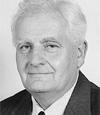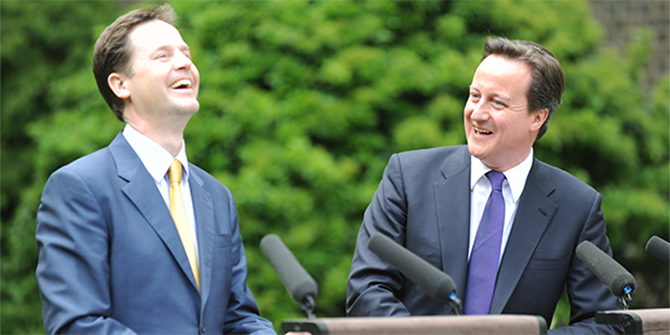
 The departure of the UK’s top civil servant and the subsequent re-shuffling of the centre of Whitehall will have a great influence on the way central government is organised. Andrew Blick and George Jones argue that the upcoming changes might increase chances for more collegial decision-making at the heart of government.
The departure of the UK’s top civil servant and the subsequent re-shuffling of the centre of Whitehall will have a great influence on the way central government is organised. Andrew Blick and George Jones argue that the upcoming changes might increase chances for more collegial decision-making at the heart of government.
Sir Gus O’Donnell, cabinet secretary and official head of the home civil service, recently announced he will be retiring at the end of this year. Accompanying this news was another story of long-term significance to the way central government in the UK is organised.
The departure of Sir Gus will mark a reconfiguration at the centre of Whitehall with the separation of the posts of cabinet secretary and the head of the home civil service. The splitting of these two roles, which we have previously recommended, is welcome: their combination, which dates to 1983, has been to the detriment of cabinet government, undermining the doctrine of collective responsibility which is central to the UK constitution.
At the centre of this twin role lay a contradiction. The cabinet secretary is responsible for supporting cabinet as a whole, while the official head of the home civil service ultimately answers to the prime minister as minister for the civil service. The years since 1983 have witnessed successive public service reform programmes, often driven from No.10, leading to the prioritisation of the role of the official head of the home civil service over that of cabinet secretary.
In 2003, Lord Butler told the House of Commons Public Administration Select Committee that he and others who held this dual role ‘all found that the role of head of the civil service became a more important one for a significantly greater part of our time’. Consequently, serving prime-ministerial agendas and managing the civil service have tended to take precedence over supporting collective government. Fused responsibility for the cabinet and for the civil service involved not just one post-holder at the top. It meant the Cabinet Office as a whole increasingly came to resemble a quasi-department of the prime minister, rather than a resource for ministers collectively.
This tendency was undesirable for various reasons. In practical terms, it meant that the benefits of collegial decision-making were harder to realise. The 2004 Butler Report on intelligence on weapons of mass destruction in Iraq gave an idea of the difficulties that can develop when policy is concentrated into excessively narrow groups. Other examples are available, ranging from W.E. Gladstone’s handling of Home Rule in the 1880s to Neville Chamberlain’s attempt to appease fascism in the 1930s. Arrangements in the Cabinet Office from 1983 created a structure sustaining this flawed non-collegiate leadership.
From a democratic point of view, a simultaneous erosion of cabinet combined with enhanced prime-ministerial involvement in government activity is problematic. Parliament is primarily focused on holding to account individual secretaries of state, in whom are vested various statutory and other powers, and to whom is voted money. The greater the direct involvement of No.10 in particular decisions, the more blurred become the lines of responsibility. For these reasons, the recreation of a freestanding cabinet secretary post, bringing with it the opportunity to enhance collective cabinet government, is the right decision, particularly if accompanied by a scaling down of the prime-ministerial nature of the Cabinet Office. A further potential boost to the cabinet secretary will be the abolition of the post of No.10 permanent secretary, a possible rival power base. The present holder of this latter job, Jeremy Heywood, has been chosen as the next cabinet secretary.
Some might argue that by being separated from the headship of the civil service, the status of the cabinet secretary will be reduced. But it could be held that, of the two newly-separated roles, the headship is the more likely to suffer. Historically, cabinet secretaries have enjoyed the prized Whitehall resource of regular access to the prime minister, and will it seems continue to do so, shoring up the importance of the position. It is not as clear that the headship will continue to provide this kind of proximity to the premier; and there are a number of other uncertainties surrounding its future operation.
The plan is that, following a competition, the headship will be given to a departmental permanent secretary. ‘He or she’, we are told ‘will provide leadership to the civil service alongside their existing departmental responsibilities’. The head will, like the cabinet secretary, ‘report directly to the prime minister’. We are pleased that this plan, if held to, could finally end the regular suggestion that a future head of the home civil service might be recruited directly from outside Whitehall. But a series of questions arise.
Is it realistic to expect anyone simultaneously to perform the tasks of a departmental permanent secretary and head of the home civil service effectively? Or will one or both roles suffer? It seems to be intended that the administrative machinery for managing the civil service will remain wholly or largely within the Cabinet Office; and there will be a new Permanent Secretary at the Cabinet Office, who will ‘support the head of the civil service on all civil service management roles’.
The person who holds this post — who will be Ian Watmore, at present head of the Cabinet Office’s Efficiency and Reform Group — will be a crucial figure, perhaps in practice more important to the day-to-day operation of the civil service than its official head. There may be grounds for concern about conflicts of interest for the new head. Is it workable for a permanent secretary who holds the headship to be accountable, albeit for formally distinct roles, to both a secretary of state and the prime minister at the same time?
Is there a danger that, in exercising the role of head, the holder of the post might be seen within Whitehall as being partial towards a particular department; or on the other hand, may be unduly restricted by the desire not to be seen in this light? Perhaps it is easier to appear a neutral arbiter when based at the Cabinet Office, which is a relatively small body at the centre of government, than it would be for a head operating out of one of the high-spending policy departments.
We do not argue that the ‘roaming headship’ will automatically be a failure. There is no perfect answer to the question of where to locate responsibility for managing Whitehall, and regular movement, if it came about, could have its merits. But if at some point the government decides that the headship should have a permanent home, then history offers three possible options. As noted above, since 1983 it has been based in the Cabinet Office. From 1968 to 1981, it was placed in a specifically created Civil Service Department. Before this point, the head of the home civil service was a Treasury official.
In austere times, basing responsibility for organisation of the bureaucracy within the office of government responsible for spending control would be a sensible option.
We have no idea who might apply for the headship. But if the job were given to a Treasury permanent secretary, then it would have come home. Perhaps it would end up staying there, with the machinery for management of the civil service following it, helping the Cabinet Office to revert to its original function of supporting collective government.
Please read our comments policy before posting.
This article first appeared in the November 2011 edition of Parliamentary Brief.








Very interesting article. Are you suggesting that, for example, the post should not go to Dame Helen Ghosh at the Home Office, assuming that she has applied? A lot of the “safe money” would have been put on her if the FT (for example) had had its way. For a bit of geographical separation, how about Gillian Morgan? She would not be “at the heart of Whitehall” every day but maybe this would be a good thing!